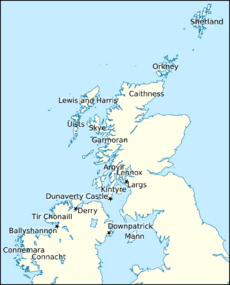Dubhghall mac Ruaidhrí facts for kids
Quick facts for kids Dubhghall mac Ruaidhrí |
|
|---|---|
| King of Argyll and the Isles Scotland | |
Dubhghall's name and title ("King of Argyll") Scotland as it appears on folio 19v of Royal Irish Academy C iii 1 (the Annals of Connacht).
|
|
| Died | 1268 possibly Norway |
| Issue |
|
| House | Clann Ruaidhrí (Clann Somhairle) |
| Father | Ruaidhrí mac Raghnaill |
Dubhghall mac Ruaidhrí (died 1268) was an important leader in the 1200s. He lived on the West Coast of Scotland, in a place called the Kingdom of the Isles. He was the son of Ruaidhrí mac Raghnaill, making him a member of a powerful family known as Clann Ruaidhrí. Dubhghall was also the last Gaelic King of Mann.
Dubhghall was also active in Ireland. He led military attacks against the English in Connacht. In 1259, after a victory over the English Sheriff of Connacht, Dubhghall's daughter married Aodh na nGall Ó Conchobhair. Aodh was the son of the King of Connacht. As a wedding gift, Dubhghall gave them many gallowglass warriors. These were special soldiers led by Dubhghall's brother, Ailéan. This is one of the first times these warriors are mentioned in history. Aodh's nickname, na nGall, means "of the Hebrideans." This shows the important help he got from the Hebridean warriors.
Dubhghall and his relative, Eóghan Mac Dubhghaill, faced many challenges. They were powerful Norse-Gaelic lords in the Isles and along Scotland's western coast. These areas were officially part of the Norwegian kingdom. However, Scottish kings in the 1200s wanted to control these lands. Eóghan eventually joined the Scots, but Dubhghall stayed loyal to Norway. He was recognized as a king by Hákon Hákonarson, King of Norway. Dubhghall played a big part in the failed 1263 war against the Scots. Even though Dubhghall kept fighting, the Scots took control of the Isles from Norway in 1266. Dubhghall might have died in Norway, where his son, Eiríkr, was an important noble.
Contents
Dubhghall's Family: Clann Ruaidhrí
Dubhghall was the son of Ruaidhrí mac Raghnaill, Lord of Kintyre. Ruaidhrí was the founder of Clann Ruaidhrí, a branch of the larger Clann Somhairle family. By the early 1200s, Ruaidhrí was likely the most important member of Clann Somhairle.
Like Dubhghall, Ruaidhrí also fought against Scotland's growing power. Scotland wanted to control Argyll and the Isles. Ruaidhrí first held power in Kintyre. But the Scottish King, Alexander II, King of Scotland, forced him out in the 1220s. The Scottish King then put Ruaidhrí's younger brother, Domhnall, in charge. Domhnall seemed more friendly to the Scots. This move by the Scottish King also led to the creation of the Clann Dubhghaill lordship in Argyll. By the mid-1200s, Eóghan Mac Dubhghaill led Clann Dubhghaill, while Dubhghall led Clann Ruaidhrí.
It's possible that Dubhghall's main power base was in Garmoran and the Uists. But we don't know exactly how or when his family got these lands. Later, other leaders of Clann Ruaidhrí certainly owned these areas. However, there is no clear proof before the mid-1200s. These lands might have been given to the family after Scotland took over the Isles in 1266. Or, their power in the Isles might have come from a marriage with the Crovan dynasty. This marriage happened before Ruaidhrí was forced out of Kintyre.
Working with Norway
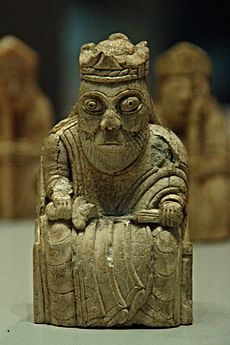
In 1248, Dubhghall and Eóghan traveled to Norway. They both wanted to be king of the northern Suðreyjar (Southern Islands). This area included the Hebrides and the Isle of Mann. It's not clear exactly which lands they wanted to rule. For example, the northern islands of Lewis and Harris and Skye were held by the Crovan dynasty. Their king was Haraldr Óláfsson, King of Mann and the Isles.
Around 1241, King Hákon of Norway had said that Haraldr's rule included only the islands his father, uncle, and grandfather had ruled. Hákon seemed to want to keep Haraldr from joining forces with Scotland. So, Eóghan and Dubhghall might have been fighting for all the other islands not given to Haraldr. They might have wanted the same lands that Hákon had given to Óspakr-Hákon about ten years earlier. This could have included some or all of the islands held by Clann Somhairle.
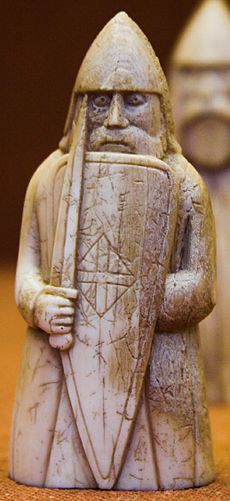
In 1247, King Hákon had his royal coronation. It's possible that Dubhghall and Eóghan came to Norway because Norway was taking back control of the Isles. Another reason might be the death of a man called Mac Somhairle. He was a member of Clann Somhairle who died fighting an English invasion in Tír Chonaill in 1247. Just a year before, Haraldr had joined forces with Henry III, King of England. So, Hákon might have made Mac Somhairle king of the Isles to get back at Haraldr. If so, Dubhghall and Eóghan might have both wanted to take their kinsman's place. Dubhghall's father might even be Mac Somhairle. Dubhghall being in Norway suggests his father was already dead by then.
An alliance with a ruler of the Isles would have helped King Henry's military plans in Ireland. Haraldr's agreement with Henry might have caused Mac Somhairle to fight the English in Ireland. Clann Somhairle might have faced problems for supporting Norway. For example, English records from 1248 show that Walter Bisset was told to strengthen a castle on the Scottish coast. This was probably Dunaverty Castle in Kintyre. Walter's actions might have been meant to divide the Isles and separate Mann from the Hebrides.
Problems with Scotland
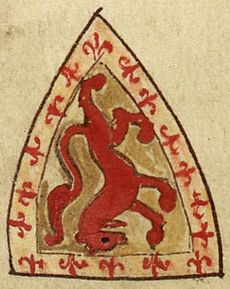
While Dubhghall and Eóghan were in Norway, King Hákon tried to get Haraldr back on his side. Hákon gave his daughter, who was a widow, to Haraldr in marriage. Sadly, the newly married couple were lost at sea while sailing from Norway to the Isles. This was a disaster for Hákon. It meant the Isles lost a good king, and Norway lost an important ally. When Hákon heard the news, he immediately sent Eóghan to the Isles to be temporary king. The Chronicle of Mann says that Haraldr's brother, Rǫgnvaldr, became king in 1249. This might mean that Rǫgnvaldr and Eóghan shared power in the Isles.
Eóghan was loyal to Norway, but he was also an important Scottish noble on the mainland. Scotland had tried to buy the Isles earlier. In the summer of 1249, King Alexander II of Scotland invaded Argyll. This was the heart of the Clann Dubhghaill lands. Eóghan's relationship with Alexander II had gotten worse. Haraldr had died, and there was fighting over who would be king. Eóghan had also accepted royal power from Hákon. All these things likely caused the Scottish attack. Alexander II demanded that Eóghan stop supporting Hákon. He also ordered Eóghan to hand over some castles. Eóghan refused. The crisis ended only when the Scottish king died suddenly in July 1249.
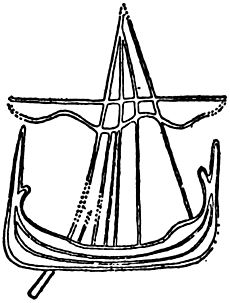
Eóghan suffered greatly because he had to choose between Norway and Scotland. He was probably completely dispossessed by the Scots after their invasion. We don't know why Hákon chose Eóghan over Dubhghall to be king at first. But Eóghan's problems with Alexander II might have changed the power balance in Clann Somhairle. For example, an old Icelandic record says that in the same year Eóghan was forced out of Argyll, Dubhghall himself "took kingship" in the Isles. This might mean that Dubhghall and Eóghan shared kingship. Or, it could mean Dubhghall took over from a weakened Eóghan. Eóghan's actions the next year also suggest he was in trouble. He and Magnús Óláfsson, another Crovan dynasty member, tried but failed to take control of Mann in 1250.
Magnús, Dubhghall, and Eóghan were back in Scandinavia in 1253. The Hákonar saga Hákonarsonar says they fought with Norway against the Danish King. By 1255, Eóghan had made peace with Scotland. Dubhghall was later called king in Scandinavian writings. This might mean that Hákon's original decision to make Eóghan king in 1248 was changed. This happened after Eóghan got his Scottish lands back. However, Dubhghall was already called king in 1249. Eóghan tried to take Mann in 1250. Both men were called kings when they fought with Norway in 1253. This could mean Hákon wanted both men to be kings. Perhaps Dubhghall ruled the Hebrides and Eóghan ruled Mann.
Fighting in Ireland
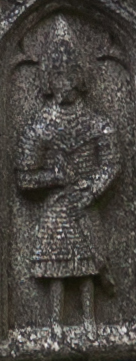
In 1258, old Irish records like the Annals of Connacht say that Dubhghall sailed to Connemara on the west coast of Ireland. He led a large fleet and robbed a merchant ship. Because of this, Jordan d'Exeter, the English Sheriff of Connacht, chased Dubhghall's fleet. The Sheriff and many of his men were killed in the fight. Dubhghall then returned home with his stolen goods.
The next record in the Annals of Connacht talks about an important meeting. Aodh na nGall Ó Conchobhair, Tadhg Ó Briain, and Brian Ó Néill, King of Tír Eoghain met that year. This meeting was at Caol Uisce on the River Erne. Aodh, son of the King of Connacht, and Tadhg, son of the King of Thomond, gave up their claims to be High King of Ireland. They chose Brian instead, who was then named High King. Brian was fighting against the English in Earldom of Ulster, and he was a close ally of Aodh.
The next year, Dubhghall was again involved in Irish matters. The Annals of Connacht and other records say that Aodh traveled to Derry. He married Dubhghall's daughter. As a wedding gift, he received 160 gallowglass warriors. These warriors were led by Dubhghall's brother, Ailéan. This marriage between Aodh and Dubhghall's family happened in Brian's main port. This shows that the marriage, the meeting, and the naval operations were all part of a plan. They wanted to work together to fight English power in northwest Ireland.
Sadly, Tadhg died by 1259. The combined forces of Aodh and Brian were completely defeated in a battle at Downpatrick in 1260. Brian was killed in this battle. Despite this loss, Irish lords started bringing more heavily armed soldiers from the Isles and western Scotland. This helped them to better fight the English forces. Aodh's connection with Dubhghall earned him the nickname na nGall, meaning "of the Foreigners" or "of the Hebrideans." There is also a chance that Brian had married a member of Clann Somhairle, perhaps a daughter of Eóghan.
Norway Loses Control
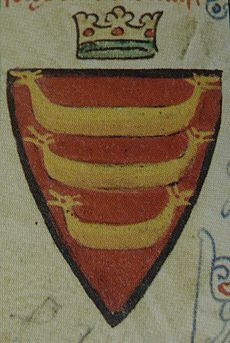
When Alexander II died in 1249, Scotland's invasion of Argyll and the Isles stopped. About ten years later, Alexander's son, Alexander III, became old enough to rule. He decided to continue his father's plans to expand westward. In 1262, after Scotland failed again to buy the Isles, the Hákonar saga Hákonarsonar says that the Scots brutally attacked the people of Skye.
This attack made King Hákon angry. He gathered a huge fleet. Old Icelandic records say it was the largest force ever to sail from Norway. He wanted to show Norway's power again along Scotland's north and west coasts. Dubhghall's son, Eiríkr, was among the important men on Hákon's own ship. In July 1263, this huge fleet left Norway. By mid-August, Hákon had confirmed his rule in Shetland and Orkney. He also forced Caithness to submit. Then, he arrived in the Hebrides.
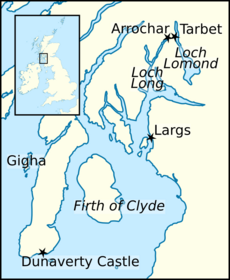
According to the saga, King Hákon met Magnús (who was then the reigning King of Mann and the Isles) and Dubhghall in the region. As the fleet sailed south, Hákon sent some ships under Dubhghall and Magnús to attack Kintyre. Hákon himself landed on Gigha. Magnús and Dubhghall were clearly meant to bring Aonghus Mór Mac Domhnaill and Murchadh Mac Suibhne to the king's side. In early September, the strengthened fleet of Norwegians and Islesmen entered the Firth of Clyde.
Peace talks between Hákon and Alexander III failed. The saga says that Magnús, Dubhghall, Ailéan, Aonghus Mór, and Murchadh led a group of Islesmen and Norwegians. They entered Loch Long, carried their ships over land into Loch Lomond, and attacked the area around the Lennox. This group had forty or sixty ships, a big part of Hákon's fleet. This attack might have been aimed at the lands of the powerful Stewart kindred. By going into the Earldom of Lennox, and possibly further east, Hákon's men were entering the Earldom of Menteith.
Meanwhile, in early October, Hákon's main force fought the Scots at Largs. They then went back to the Hebrides. Once they rejoined the other group, the saga says Hákon rewarded his supporters from overseas. Eóghan had refused to help Norway. So, Dubhghall and Ailéan were given his forfeited island territories. A man named Ruðri received Bute, and Murchadh got Arran.
Many of Hákon's strongest supporters from the Isles had close ties to Ireland. The saga says that Hákon had received offers from the Irish. They wanted the Norwegians to fight the English in exchange for ruling Ireland. The saga says the king was eventually talked out of these Irish offers. He died in Orkney that December. However, Irish records say he died while coming to Ireland. Magnús might have been allied with Brian. And the fact that Brian's ally Aodh was allied with Dubhghall and Ailéan strongly suggests that Aodh himself had asked Norway for help. This invitation might have been one of the most clever ideas in Ireland in the 1200s. Aodh's relationship with Clann Ruaidhrí and his offers to Norway show how far some Irish lords would go to overcome English power in Ireland. Dubhghall, Ailéan, and Magnús strongly supported Norway against Scotland. They were also involved in Irish affairs. This suggests they were the men Alexander tried to stop from entering Ireland just before the battle at Downpatrick.

The Hákonar saga Hákonarsonar says the operation was a huge success. But it seems it was actually a big failure. Hákon did not break Scotland's power. Instead, Alexander III took control the next year. He led several invasions into the Isles and northern Scotland. Magnús saw this big change in power. He submitted to Alexander III that year. This showed that Norway had completely lost control of the Isles. Dubhghall, however, was different from many other Islesmen. He stubbornly refused to submit to Scotland.
The 1200s Magnúss saga lagabœtis says he kept fighting. He led military attacks against the Scots in Caithness. This source says Dubhghall attacked the Scots while they were collecting a fine from the people of Caithness. He took much of their treasure and killed many Scots. This fine might be the one mentioned in Scottish records. It says two hundred cattle were taken from the Caithnessmen. In 1266, almost three years after Hákon's failed campaign, Scotland and Norway finally agreed to peace terms. With the Treaty of Perth in July, Hákon's son, Magnús Hákonarson, King of Norway, officially gave up all rights to Mann and the islands on Scotland's western coast. This finally settled the dispute over Scotland's western sea region.
Dubhghall died in 1268. His death is recorded in Icelandic and various Irish annals. These include the Annals of Loch Cé, the Annals of the Four Masters, and the Annals of Connacht. The Annals of Connacht calls him "King of Argyll". This might support the idea that Mac Somhairle was indeed his father. Dubhghall's death is not mentioned in Scottish records. It's possible he died in Norway. His son, Eiríkr, remained loyal to Norway and was an important noble there.
After the 1260s, Clann Ruaidhrí disappears from Scottish history for a while. When they reappear in 1275, it's through Dubhghall's brother, Ailéan. By then, Ailéan was an important Scottish noble and leader of Clann Ruaidhrí. Unlike Dubhghall, Ailéan is not given any royal title in old records. However, a Clann Ruaidhrí chief in 1318 was called rí Innsi Gall (King of the Isles). This might have been one of Ailéan's sons, and the title might have been inherited from Ailéan. During Ailéan's time, the family became part of the Scottish kingdom. His descendants continued to be important in Scottish history well into the 1300s. Another son of Dubhghall, Donnchadh, is mentioned in the late 1200s.


